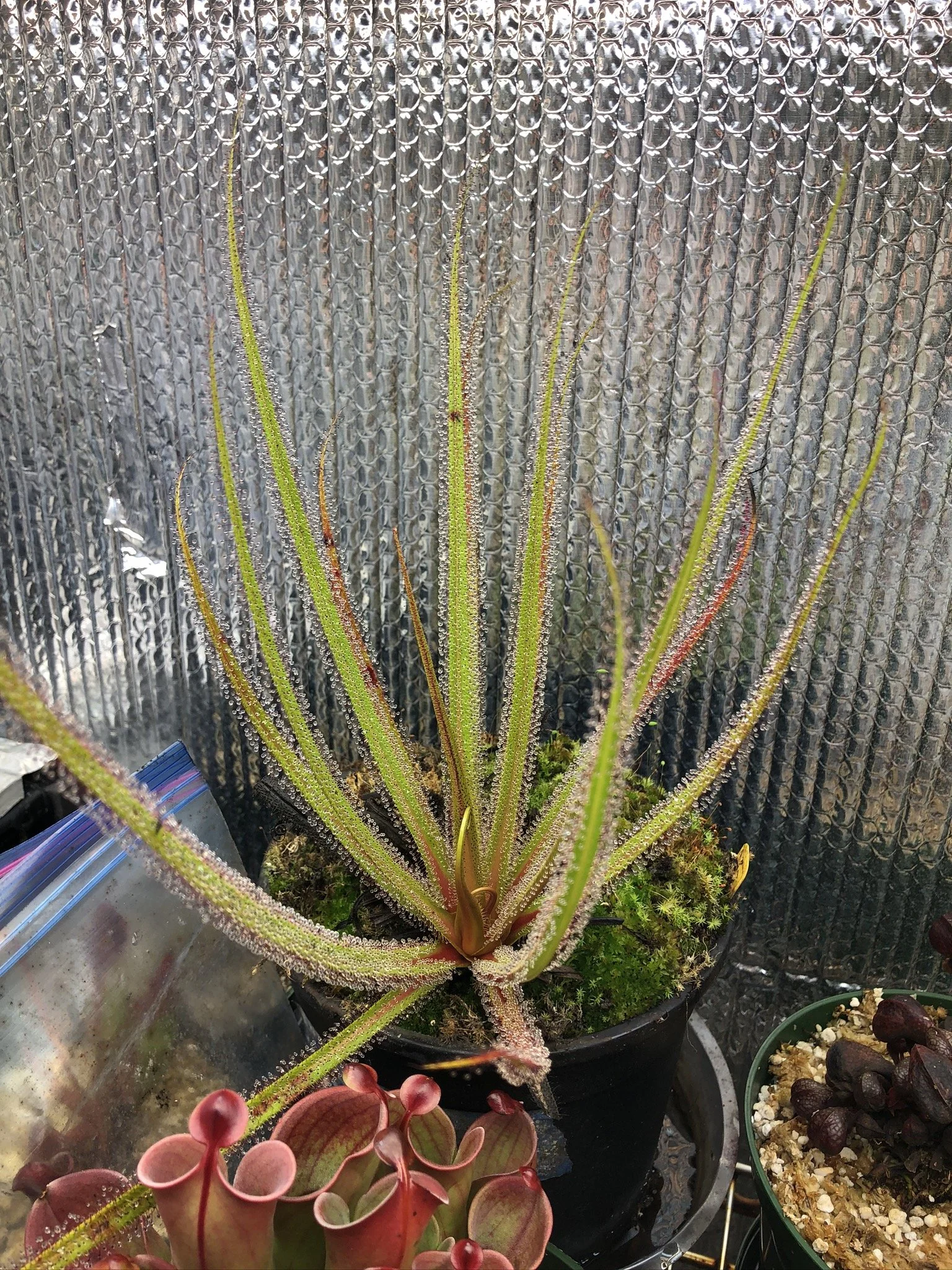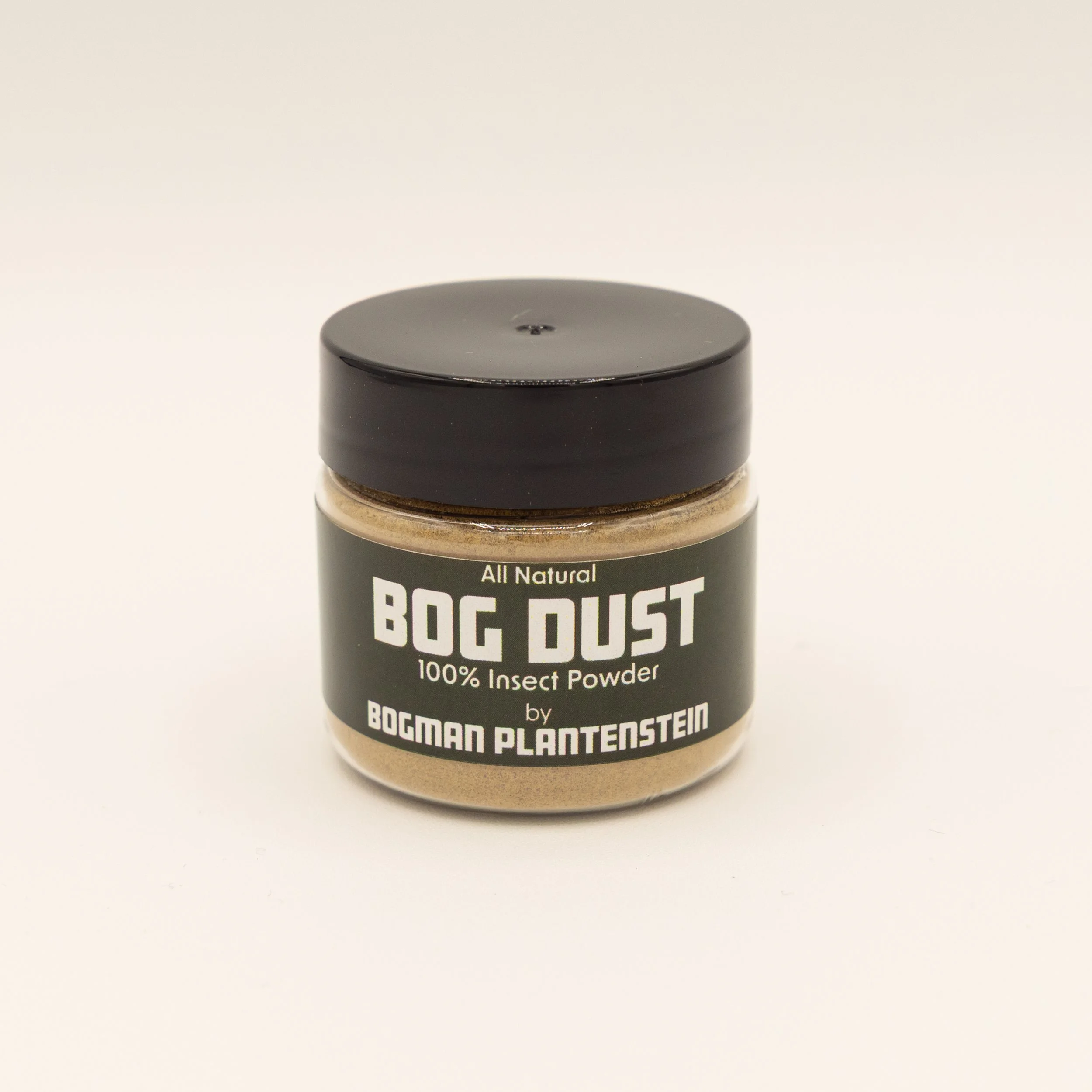 Image 1 of 7
Image 1 of 7

 Image 2 of 7
Image 2 of 7

 Image 3 of 7
Image 3 of 7

 Image 4 of 7
Image 4 of 7

 Image 5 of 7
Image 5 of 7

 Image 6 of 7
Image 6 of 7

 Image 7 of 7
Image 7 of 7








Drosera regia
Description
Drosera regia is known as the King Sundew for it’s massive size, with the largest leaves of all sundews. The lance-shaped leaves can grow up to 2’ in length with huge dew drops. Smaller leaves can not only curl their tentacles, but will also bend and twist the leaf blade to wrap around large prey. An old plant can split into many growth points to almost form a bush of giant, sticky leaves. It is distantly related to the other Drosera and some say it coule be its own genus. Undoubtedly one of the most desirable of all the carnivorous plants and a spectacular plant in any collection.
Native to South Africa, these grow in the small mountains of the Western Cape in well-drained, moist soils. They can grow to a huge size incredibly fast, but this requires heavy feeding. Unlike other sundews, Drosera regia benefits from root fertilization. To grow this successfully requires cool temperatures, strong light, proper winter dormancy, and regular feeding. While it can grow without winter dormancy as a young plant, most growers find that long-term health requires seasonal cues. This can be as simple as changing the photoperiod in winter which induces a mild dormancy of small leaves and slow growth. In spring, massive new leaves will emerge.
Small plants will have leaves 1-2” long and will be in 2.5” pots. Medium plants will have leaves 2-4” long and will be in 3.5” pots. Large plants will have leaves >4” long and will be in 3.5” pots or larger.
WINTER SHIPPING: Cold winter temperatures (<40F) require heat packs which will be automatically included with the shipment if necessary. This species goes dormant in winter where it will either shrink significantly or die back to a dense bud.
Growing Information
Climate: Cool Mediterranean climate is best, roughly 40-90F, especially limiting heat in summer. It can survive a light frost by dying back to the roots to re-emerge in spring. Ideally it will stay below 90F but it can tolerate higher temperatures if the roots can stay cool. High humidity is not necessary and can actually promote rot — lower humidity is best.
Light: Part to Full Sun or at least 15W per sq ft LED light. They love light and will grow floppy, elongated, green leaves in overly dim conditions.
Water: Distilled or Reverse Osmosis water. Sitting in 0.5”-1” of water using tray method, or regular top watering. These prefer not to be overly soggy but do fine in trays with adequate light and feeding.
Soil: Soil can be pure long-fibered sphagnum moss or peat/perlite/sand mixes. It is not picky, but prefers peat based mixes in my experience, and especially sphagnum moss. Use very large and deep pots as the roots can grow several feet long on mature plants.
Feeding: Drosera regia requires regular feeding to survive long-term. The leaves can be fed with Insect Powder or bugs and they will dramatically curl around the food. Drosera regia can also be root fertilized with dilute Dynagro Foliage Pro or MaxSea. A solution of 300-400ppm can be made, using ~1mL per inch of pot diameter.
Description
Drosera regia is known as the King Sundew for it’s massive size, with the largest leaves of all sundews. The lance-shaped leaves can grow up to 2’ in length with huge dew drops. Smaller leaves can not only curl their tentacles, but will also bend and twist the leaf blade to wrap around large prey. An old plant can split into many growth points to almost form a bush of giant, sticky leaves. It is distantly related to the other Drosera and some say it coule be its own genus. Undoubtedly one of the most desirable of all the carnivorous plants and a spectacular plant in any collection.
Native to South Africa, these grow in the small mountains of the Western Cape in well-drained, moist soils. They can grow to a huge size incredibly fast, but this requires heavy feeding. Unlike other sundews, Drosera regia benefits from root fertilization. To grow this successfully requires cool temperatures, strong light, proper winter dormancy, and regular feeding. While it can grow without winter dormancy as a young plant, most growers find that long-term health requires seasonal cues. This can be as simple as changing the photoperiod in winter which induces a mild dormancy of small leaves and slow growth. In spring, massive new leaves will emerge.
Small plants will have leaves 1-2” long and will be in 2.5” pots. Medium plants will have leaves 2-4” long and will be in 3.5” pots. Large plants will have leaves >4” long and will be in 3.5” pots or larger.
WINTER SHIPPING: Cold winter temperatures (<40F) require heat packs which will be automatically included with the shipment if necessary. This species goes dormant in winter where it will either shrink significantly or die back to a dense bud.
Growing Information
Climate: Cool Mediterranean climate is best, roughly 40-90F, especially limiting heat in summer. It can survive a light frost by dying back to the roots to re-emerge in spring. Ideally it will stay below 90F but it can tolerate higher temperatures if the roots can stay cool. High humidity is not necessary and can actually promote rot — lower humidity is best.
Light: Part to Full Sun or at least 15W per sq ft LED light. They love light and will grow floppy, elongated, green leaves in overly dim conditions.
Water: Distilled or Reverse Osmosis water. Sitting in 0.5”-1” of water using tray method, or regular top watering. These prefer not to be overly soggy but do fine in trays with adequate light and feeding.
Soil: Soil can be pure long-fibered sphagnum moss or peat/perlite/sand mixes. It is not picky, but prefers peat based mixes in my experience, and especially sphagnum moss. Use very large and deep pots as the roots can grow several feet long on mature plants.
Feeding: Drosera regia requires regular feeding to survive long-term. The leaves can be fed with Insect Powder or bugs and they will dramatically curl around the food. Drosera regia can also be root fertilized with dilute Dynagro Foliage Pro or MaxSea. A solution of 300-400ppm can be made, using ~1mL per inch of pot diameter.


